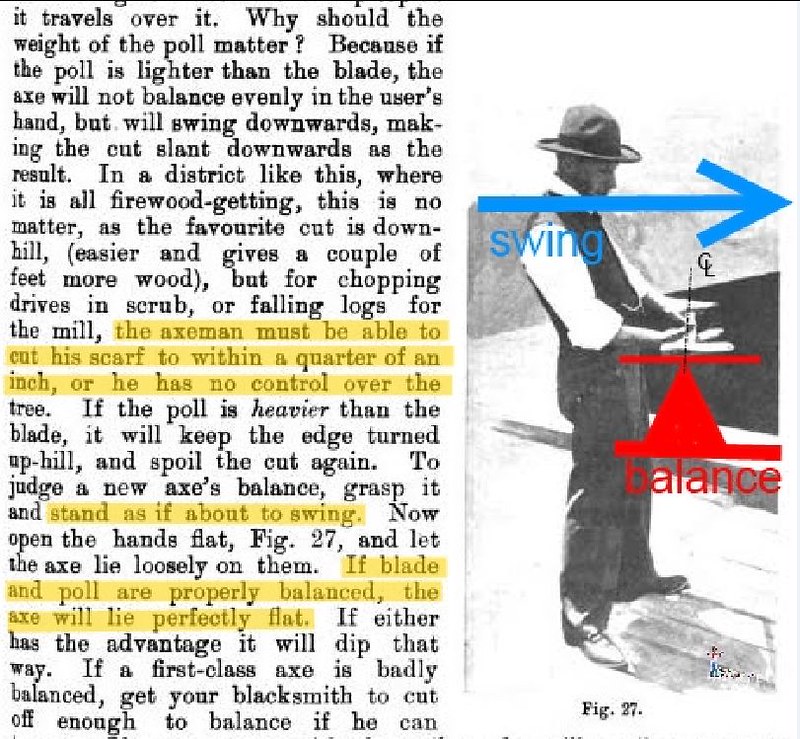Let's see if I understand this so far:
An "axle" (the "axis of rotational balance") is a line from a "grip point" on an axe through its center of gravity.
There are an infinate number of "grip points" on an axe.
Therefore there are an infinate number of "axles".
If you chuck an axe in a lathe so that any "axle" is on the same line as the line between centers, then the axe will spin smoothly (no wobble).
I assume that the lathe example is used because it has relevance to an axe swing.
If I have a correct understanding of your terms "axis of rotational balance", "axle" and "grip point", then the following seems ambiguous to me:
My reason is that the lathe example includes all possible "grip points" and always produces the same result - spinning "true and vibration-free". How will the "grip point" effect the "stroke"?
Bob
You mostly have it, except for all axles producing the same result. They do always produce a balanced tool--an axis around which the tool will self-balance (or attempt to self-balance if more than one axle is in play) BUT the orientation of the axle relative to the tool changes the presentation of that tool during the stroke. For instance, in an extreme example, if you were to make your grip point on the head itself by wrapping your hand around the bit, you'd have an axle running from the grip point through the center of gravity, still, but you'd be presenting the handle to the target instead of the head.
There is virtually no one alive today that uses (or at one time used) an axe to make a living but there are hundreds of thousands of these old chopping tools still kicking around. Judging by the wear on many of these oldies they probably experienced 1/2 century of constant use. Why is it then that we very rarely find worn oddball unbalanced heads or even screwball handles? Users don't need physics or engineering lessons in order to be productive with an axe. All they need is to experience what works and what doesn't, and overwhelmingly this turns out be conventional-balance designs.
There are a few factors at play there, but here's the abbreviated version. One factor is that people are opportunistic and inherently "lazy" in that they will usually take the path of least required thought or personal effort to get a job done--it's "bird in the hand" syndrome at work. As such, most people the world over use what tools they can buy at the local store or otherwise off the digital "shelf" at places like Amazon, and use them in the condition they came in or close to it. Clearly this is not model axe use. We also find, constantly, old axes with goodness-knows-what jammed in the eye to tighten the head, or heads hafted upside down. With blunt, dinged up edges. Because the guy swinging it didn't know, didn't care, and worked easily ten times as hard as a result. However, those people throughout history have benefited from the technological trickle-down of innovators and makers/manufacturers pushing the performance of their tools to adapt them to the changing needs of the market.
There have always been axes made for professionals and those made for household/pedestrian use, and a whole range between, with different intended applications, price points, and preferences at work in determining optimized tool forms. This is largely a responsibility not in the hands of the consumer. They buy it and swing it. But there are those in the marketplace that are the frontier of innovation of an industry's tools, and feels motivated enough to communicate with makers or manufacturers to tell them "for my work I'd prefer something a little more like ______." Regional styles largely evolved in this sort of manner, and later on such folks would have local smiths make a tool for them and they'd send it off to a large maker for use as a pattern. The jobber system that was commonly used by hardware stores allowed for a lot of communication between buyers and sellers, and the manufacturing methods of the day allowed for a lot of flexibility in pattern production. Over time certain fundamental design aspects had become prioritized and institutionalized as familiar by the peoples of a region, and so that
tends to form the foundation off of which all other designs are based.
But ultimately, it comes down to some guy swinging an axe somewhere to get a job done, and even if the mind doesn't consciously understand what's going on with the tool, the subconscious is hard at work doing what adjustments it can to make the tool behave as the user desires. Sub-par tools can, and usually do, still get the job done and if the user is none the wiser then it doesn't bother them much--they don't know what they're missing!


